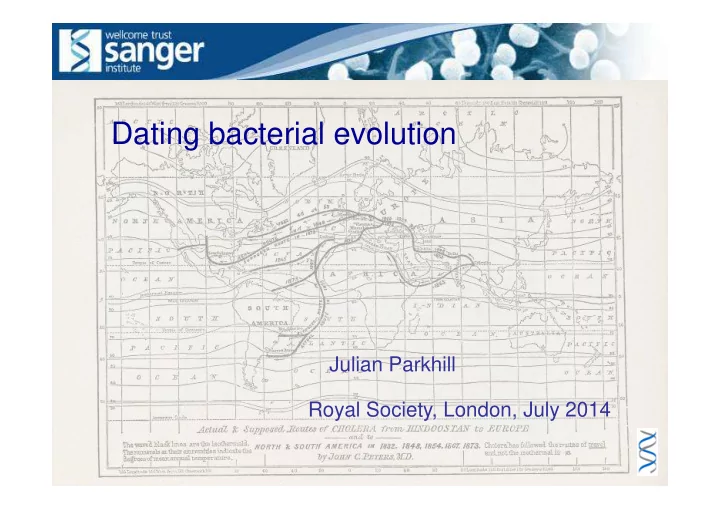

Dating bacterial evolution � Julian Parkhill � Royal Society, London, July 2014 �
Estimating bacterial mutation rates � • Bacteria leave no fossil record, so dating lineages is difficult • Previous best estimates were based on divergence of Salmonella and E. coli and gave a rate of 6x10 -9 mutations per synonymous site per year • This has led to hypotheses that many bacterial diseases are old, and the youngest may have been associated with the Neolithic revolution, or expansion of humans out of Africa
Staphylococcus aureus population structure by MLST � TW20 (ST239) CC1 CC51 CC8 CC22 CC39 CC30 CC5 CC45 CC12 CC25 CC15 CC9
SNPs in 63 closely-related Staphylococcus aureus (ST239) � 6,714 total SNPs; 4,310 SNP sites in core sequence Harris et al (2010) Science 327:469
Random occurrence of SNPs in ST239 � mutation rate = 3.3 × 10 − 6 per site per year = 7.5 SNPs per genome per year - Bacteria have measurably evolving populations Harris et al (2010) Science 327:469
Identifying transmission within S. aureus ST329 � Congruence of tree and lack of recombination allows ready identification of intercontinental transmissions 81 SNPs to LCA ~ 9 years 15 SNPs to LCA ~ 1.5 years Harris et al (2010) Science 327:469
Mycobacterium abscessus phylogeny � Tightly Clustered Deep divergences between Loosely Clustered isolates different patient isolates isolates 4_a 4_b 25_a 16_a 5_k 32_b h _ 5 c _ 5 32_a m _ 5 5_e 1_h 5_f 1_f 5_b 5_d 1_g 5_i 1_b 5 _ a 5_o Maximum likelihood tree of 1_d 5_n 1_e 5_p 200 isolates 1_c 5_l 5 21_c _ j 21_b 5_g 21_a 10_a 21_d 10_d 10_b 2 3 _ a 1 1 _ a 10_c 1 1 _ c 11_e 11_b 5000 SNPs 11_d 209SNPs Bryant et al. 2013 Lancet 381 :1551
Dating of possible M. abscessus transmission events � 2010 2000 a _ 4 4_b 5_k 16_a 5_h 5_c 5_m 1990 e _ 5 f _ 5 _ b 5 _ d 5 5_i 5_a 5 _ o 5_n 5_p Estimated(age(of( 5 _ l 5_j 2 1 _ c 1980 2 1 5_g _ 2 b 1 _ a 2 1 _ d common(ancstor 23_a 11_a 11_c 11_e 11_b 11_d 1970 Patients(4(&(5 M.a.$abscessus 1900 1890 Bryant et al. 2013 Lancet 381 :1551
Vibrio cholerae – El Tor dated tree � Mutreja et al. 2011 Nature 477 :462
Vibrio cholerae – repeated global transmission � 1974 2005-09 1993-98 1969-73 2003-07 1975-86 1969-73 1969-81 1989-97 1966-71 1937-61 1967-89 1981-85 1992-2002 Wave 1 � Wave 2 � Wave 3 � Mutreja et al. 2011 Nature 477 :462
Vibrio cholerae – introduction to Haiti � Katz et al 2013 mBio 4 :e00398
Bordetella pertussis phylogeny � MRCA 286 BC (1582 AD-1330 BC) First documented pertussis outbreak: Paris 1578 MRCA 1678 (1587-1752) Harris et al 2013 mBio 5 :e01074
SCBU MRSA outbreak � ID P26 Community P25 P24 P23 P25 P22 H Maternity ward H P21 H MRSA screen Hx2 P20 Hx2 negative P19 H H P15 H P22 H P9 SCBU P18 P24 H H P8 MRSA screen P17 Hx5 H & SNPs from root negative P21 P16 H � 1 P17 2 P11 & 12 P2 & 3 P15 3 P5 P10 4 P14 P13 5 P14 & 23 6 P13 P7 P1 P6 7 P12 P20 8 H 9 P11 P4, 16 & 19 10 P10 11 P26 P9 SCBU P8 MRSA screen P7 positive P6 P5 P4 P3 P2 P1 0 50 100 150 200 250 300 350 Harris et al. 2013 Lancet Infect Dis. 13 :130
Conclusions � • Dating bacterial evolution gives us clinically useful information • It also informs us about the origin of pathogenic lineages • The evolution and emergence of many bacterial pathogen lineages is very recent • Traditional ideas of pathogen emergence alongside key events in human evolution (e.g. the Neolithic Revolution) may be untrue • Pathogen emergence may be a rapid and ongoing process • This would imply that pathogen extinction is equally frequent
Myanmar �
Recommend
More recommend